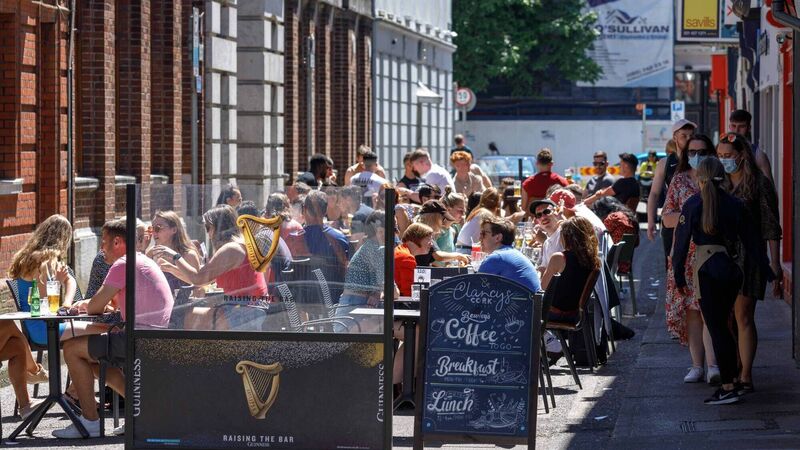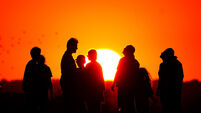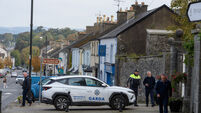Catherine Conlon: Heatwaves show the need to decarbonise Cork and other cities

Eighteen streets in Cork city centre have been permanently pedestrianised, leading to a huge growth in outdoor dining and a more attractive and vibrant urban centre. The city can now accommodate up to 1,000 residents to eat and drink al fresco, helping to create a liveable, people friendly city. Picture: Damian Coleman
As Europeans swelter in the latest summer heatwave, many have begun to challenge the dominance of cars in their cities at the expense of everything else. Though changes are often met with initial outrage from a vocal minority, what is clear is that decarbonising our cities is essential for improving physical and mental wellbeing, combating the lethal effects of air pollution and global warming.
The health benefits of urban green spaces are well recognised for children and adults, whose physical and mental development is enhanced by living, playing, and learning in green environments. The World Health Organisation (WHO) recommends that all people reside within 300 metres of green space. Within cities, the degree of greening varies across neighbourhoods with less and lower quality green space typically found in low-income communities.
This challenge is being taken on in many cities in Europe. Guiseppe Sala won 42% of the vote in 2016 when he became Mayor of Milan. He proceeded to take the streets back for the people by adding cycleways to main travel corridors and with the Piazza Aperte programme, he created almost 40 community piazzas.
Half of Milan’s 1.35m residents are now within walking distance of new public spaces, much of it reclaimed from cars using planters and the expansive application of paint. The first three squares of the Piazza Aperte programme were created in car-heavy neighbourhoods on the outskirts of Milan. Street parking was removed and replaced with benches and planters while whole streets of asphalt were brightly painted and patterned.
Milan, Italy is known for its beautiful architecture and historic piazza's but for the past year, the City has been innovating in the pavement to plaza world creating new, vibrant public spaces through their #PiazzaAperte program. 📷@demescope #citiesforpeople pic.twitter.com/2VFGqcPZ6N
— Patronicity (@Patronicity) October 11, 2019
A further 35 piazzas have been created, many in low- income areas. Intersections previously clogged with traffic have been replaced with public piazzas and ping pong tables. Some of the first areas to be transformed included the working-class districts of Spoleto and Durgano. Sadik-Khan of Bloomberg Associates acted as advisor on the project.
"If you want to transform a city and have an impact on the world, one of the most effective things you can do is reclaim and re-imagine your streets for people. These changes are popular – once you have city streets and public space filled with people, it’s hard to argue that it should be any other way."
Similar plans have been put forward in Barcelona. In 2000, mayor Ada Colau launched a 10-year plan to create green zones that discourage car use and give priority to pedestrians and walkers.
The plan, now radically extended was dubbed Superilla or Superblock, puts several city blocks in a cluster, closing them off to through-traffic with the help of plants, picnic tables and benches installed in former parking spaces. Playgrounds and fountains form a backdrop with cycling lanes cutting through.
Superilla🌱✨💜 pic.twitter.com/mMbtygLSKQ
— Carme Rocamora i Seguí 🍉 (@carmerocasegui) July 17, 2022
Despite the opposition of car lobbies, the Superilla received huge public approval and the government is now moving on with plans from June 2022 to create four large and 31 smaller squares as well as four green streets in L’Eixample, the district with the most pollution and fewest public spaces.
Key features of the new street model include:
- Pedestrians will have top priority.
- Speed limits of 10 km/ hour will be introduced for cars, giving them guest status.
- Urban services and emergency services will have unrestricted access.
- Streets will have no pavements.
- Asphalt will be replaced with paving stones and granite slabs.
- More benches, fountain areas, play areas and pavements will be installed.
- Trees with leafy foliage will be planted in central street sections to provide more shade.
- The ground will be water permeable and a system for reusing rainwater will be installed.
- Lighting will be renovated to cater for the needs of people rather than vehicles.
Four streets and squares in L’Eixample are just the first stage in the major facelift to this busy central part of Barcelona which will see 21 green streets and 21 large squares created by 2030.
Paris embraced city conviviality in 2017, with a 215-metre-long banquet table, lined with 648 chairs and laden with home-cooked produce along the inner city Rue de l’Aude. Those in attendance were asked to turn left and right and say ‘bonjour’ to the person sitting next to them. For some, saying bonjour led to the first meaningful exchange between neighbours.
The experiment encouraged people not just to salute each other more but to interact daily through mutual aid schemes, voluntary skills-sharing and regular arrangements to meet.
The group pledged their allegiance that day to the self-styled Republique des Hyper Voisins or Republic of Super Neighbours, a stretch of the 14th arondissement on the Left Bank, encompassing roughly 50 streets and 15,000 residents. In the five years since, the republic – a ‘laboratory for social experimentation’ – has attempted to address the shortcomings of modern city living, that can be transactional, fast- paced and lonely.
Nearly 2,000 people now attend weekly brunches and aperitifs in local restaurants, cultural outings, and events. During the pandemic, residents mobilised to make masks, deliver shopping, and bake cakes. Crucial too is the digital aspect: dozens of WhatsApp groups include those dedicated to broken devices, selling second-hand goods, and sharing healthcare resources.
Cork Healthy Cities has taken on this challenge with the Green Spaces for Health community-led initiative. Achievements include the redevelopment of Parkowen in the centre of the city in South Parish. A former cemetery, it is now a public park focusing on re-wilding and hedgerows.
We celebrate the 10 Year designation of #CorkCity by WHO European Healthy Cities Network @WHO_Europe_HCN this month.
— Cork Healthy Cities (@CorkHealthyCity) January 3, 2022
Check out today's Special feature by @EoinBearla in @irishexaminer a great account of some of the achievements we have made along the way
https://t.co/BtBzCINzry
Beehives have been established on the rooftop of St John’s Central College and a multi-partner group Re-Imagining South Parish is looking to re-imagine the evolution of the area with health, inclusivity, and environment as central themes.
Eighteen streets in Cork city centre have been permanently pedestrianised, leading to a huge growth in outdoor dining and a more attractive and vibrant urban centre. The city can now accommodate up to 1,000 residents to eat and drink al fresco, helping to create a liveable, people friendly city.
"The stereotype of a Parisian is brusque and unfriendly," says Patrick Bernard, the former journalist and local resident who launched the République des Hyper Voisins. "But city living doesn’t have to be unpleasant and anonymous. We want to create the atmosphere of a village in an urban space.
This principle embraces all those values we hold dear in a modern world in the thrall of physical and mental health, addiction, cost of living, energy, biodiversity, and climate crises all compounded now by war. Is it time to transform the way the think and move and live our lives?
Rather than creating cities to facilitate rapid transit, what if we placed conviviality between neighbours and friends at the centre of how the city works? Rather than focusing on the advantages of every adult owning a car, how much more convivial and healthier and joyful our lives could be if most of those cars were removed from our streets and replaced with piazzas, trees, benches, tables, and people?
- Dr Catherine Conlon is senior medical officer in the Department of Public Health, St Finbarr’s Hospital, Cork and former Director of Human Health and Nutrition, safefood. All views are author’s own.
CLIMATE & SUSTAINABILITY HUB
















